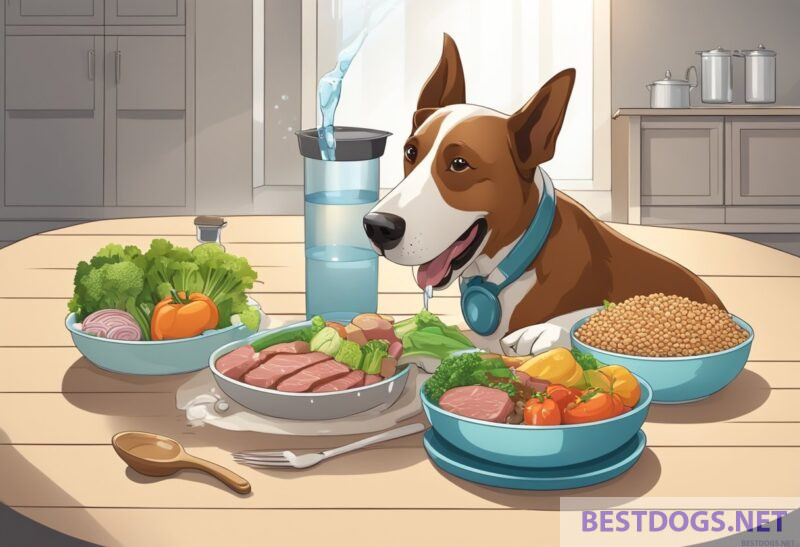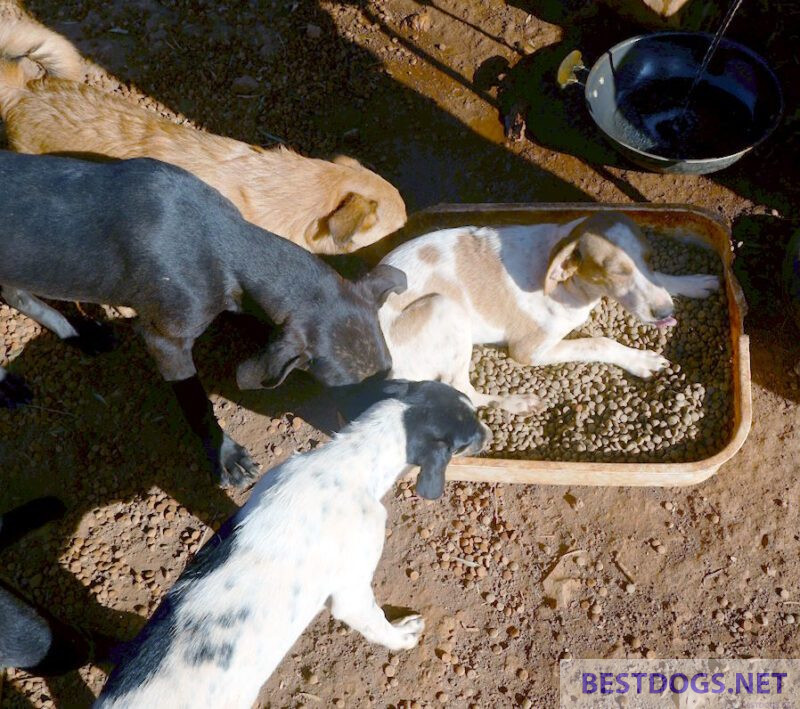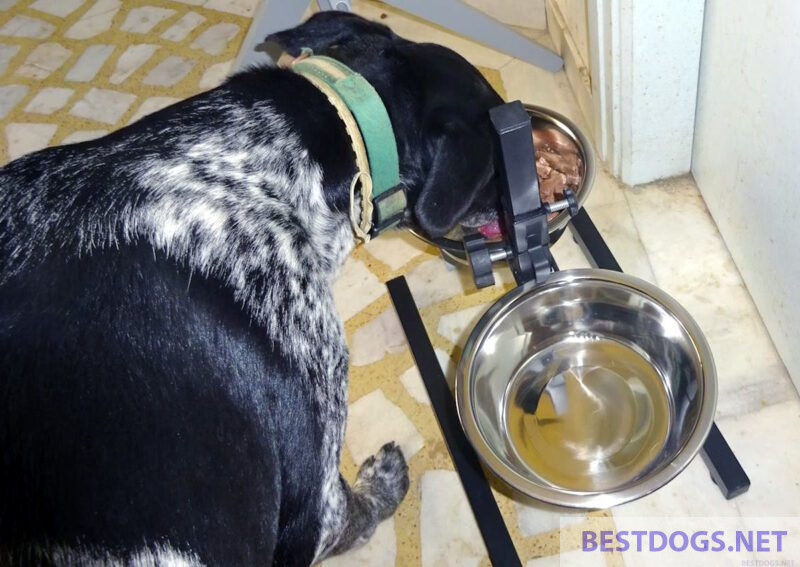The Best Food and the Right Diet for Dogs: Tailored Nutrition for Your Canine.

The best food and the right diet for dogs
Table of Contents
Choosing the best food for a dog is crucial to ensuring they live a happy, healthy life.
Every dog has specific nutritional needs that vary according to their age, breed, weight, and activity level.
A balanced diet for dogs should contain proteins, fats, carbohydrates, vitamins, and minerals in the right proportions.
Not all dog foods are created equal; it’s important to select a diet that provides comprehensive nutrition and caters to any special health concerns.
In the past, owners made up their own food for their dogs, but nowadays ready-made food dominates the market. It is usually formulated according to nutritional science, has a more balanced composition, is not overly expensive, is easy to prepare and is subject to the same legal regulations as food for humans in terms of production and composition of the individual ingredients.
Nutritionists often emphasize the importance of quality ingredients. They recommend looking for foods where meat, vegetables, grains, and fruits are listed among the top items on the ingredient label.

Understanding the right diet for a dog involves more than just picking a quality brand off the shelf.
The life stage of a dog, whether it be a puppy, adult, or senior, greatly influences their dietary requirements.
Puppies require diets rich in protein and calories to support their rapid growth, while senior dogs may benefit from lower-calorie diets that include fiber to help them maintain a healthy body weight and nutrients such as omega-3 fatty acids for joint health.
Consulting with a veterinarian or a canine nutritionist can help owners make informed decisions about their dog’s nutrition.
In the quest for the best dog food, it’s also essential to consider a dog’s individual preferences and any food sensitivities or allergies they may have.
Some dogs might thrive on grain-free diets, while others may require grain-inclusive foods.
The ideal dog food should not only meet the nutritional requirements but also be palatable to ensure consistent intake.
Balancing the science of nutrition with the preferences of each dog ensures they not only receive the sustenance they need but also enjoy their meals.

A wholesome diet for dogs involves a careful balance of protein, fats, carbohydrates, vitamins, and minerals to ensure their optimal health and vitality.
Essential Nutrients and Their Functions
Proteins: They serve as the building blocks for tissues, organs, and are vital for repair processes in a dog’s body.
Fats: They provide a concentrated source of energy and are necessary for the absorption of certain vitamins.
Carbohydrates: While often considered less critical, they supply energy and help in proper digestion and bowel health.
Vitamins and Minerals: These are required in small quantities for a range of bodily functions, including bone health and immune system support.
The Role of Protein in a Dog’s Diet
Protein is crucial for the maintenance of a dog’s muscle structure and function, as well as hair growth, tissue repair, and enzyme production. High-quality animal-based sources of protein should be a key component of any canine diet.
Vitamins and Minerals Vital for Dogs
- Calcium and Phosphorus: Essential for healthy bones and teeth.
- Potassium: Regulates fluid balance and nerve function.
- Iron: Required for oxygen transportation in the bloodstream.
- Zinc: Supports the immune system and skin health.
- Vitamin A: Important for vision and immune function.
- Vitamin E: Acts as an antioxidant, protecting cells from damage.
- B Vitamins: Aid in energy metabolism and maintain healthy skin and nerves.
Different life stages come with varying nutritional demands that are critical to a dog’s health and wellbeing. The right balance of nutrients supports growth, maintenance, and the aging process, ensuring dogs thrive at every age.
Puppy Nutrition Essentials
Puppies require diets rich in protein to support rapid growth and development.

Essential nutrients like calcium and phosphorus must be carefully balanced to promote proper bone formation. According to Hill’s Pet, small breed puppies have higher metabolic rates and energy needs per pound of body weight compared to larger breeds.
- Protein: High-quality protein for muscle growth.
- Fats: A crucial source of energy and for brain development.
- DHA: An omega-3 fatty acid essential for brain and vision development.
Adult Dog Dietary Needs
Once dogs reach adulthood, their diets should shift to maintaining a healthy weight and sustaining energy levels.
Adult dogs need a well-rounded diet that provides a balance of proteins, carbohydrates, and fats, as recommended by experts at Dog Food Advisor.
- Calories: Matched to energy expenditure to avoid weight gain.
- Fiber: Important for digestive health.
- Protein and Carbs: Sustain energy levels throughout the day.

[amazon_link asins=’B00DAMMC1K, B0BN7P7PBD, B0C28X7LYX’ template=’ProductGrid’ store=’wwto-20′ marketplace=’US’]
Senior Dog Nutrition Considerations
Senior dogs often have lower energy requirements and may need diets that cater to age-related challenges, like joint health and cognitive decline. According to Vca Hospitals, food for senior dogs should contain fewer calories to match their slower metabolism.
- Glucosamine and Chondroitin: Support joint health.
- Omega-3 Fatty Acids: Can help with inflammation and cognitive function.
- Lower-Calorie Diet: Helps prevent obesity in less active senior dogs.
Selecting the right dog food involves carefully examining labels, seeking expert advice, and understanding nutritional regulations. By prioritizing these aspects, dog owners can ensure their pets receive a balanced diet tailored to their specific needs.
Reading and Understanding Dog Food Labels
A dog food label is a gateway to understanding the product’s contents.
The ingredient list should state a clear protein source such as chicken or lamb as one of the first items, indicating it as a primary component.
Ingredients are listed by weight, with the heaviest ones appearing first, typically including moisture-rich items like meats.
Dog owners should look for whole food ingredients and be cautious of generic terms like “animal by-products,” which can vary in quality.
The label should also include a nutritional adequacy statement from the Association of American Feed Control Officials (AAFCO), attesting that the food is complete and balanced for a dog’s life stage.
Tips from Veterinarians on Choosing Dog Food
Veterinarians often emphasize the importance of a diet that aligns with a dog’s age, breed, and health conditions.
They may recommend dog food brands known for their rigorous quality standards and nutritional research.
Ideal dog food should have a balanced proportion of nutrients, including a crude protein content appropriate for the dog’s lifestyle – higher for active dogs, less for sedentary ones.
Regular consultations with a veterinarian or nutritionist can guide dog owners in adjusting diets as their dogs age or their health needs change.
The Importance of AAFCO Guidelines
The AAFCO plays a pivotal role in the regulation of pet food standards.
AAFCO guidelines ensure that dog foods meet minimum nutritional requirements that are essential for a dog’s health.
These guidelines include detailed feeding guidelines to help owners understand how much to feed their pets to prevent underfeeding or overfeeding.
The presence of an AAFCO statement on dog food packaging means the food has met or exceeded the strict criteria for nutritional adequacy.
Dog owners should prioritize products adhering to these guidelines to maintain their pets’ well-being.
When selecting the best food and diet for dogs, one must consider the types of dog food available, such as dry kibble and wet food, as well as specific diets like grain-free.
It’s equally important to understand feeding patterns, including scheduled meals and free-feeding, to ensure the dog’s nutritional needs and calorie intake are appropriately managed.
Pros and Cons of Dry vs. Wet Food

Dry kibble is a convenient and economical option that provides a balanced diet with a longer shelf life.
It’s beneficial for the dog’s dental health due to its abrasive texture which helps reduce plaque.
Wet food, on the other hand, has a higher moisture content which is good for hydration and can be more palatable for picky eaters. However, it’s typically more expensive and perishable once opened.
-
Dry Food (Kibble)
- Pros:
- Cost-effective
- Good for dental health
- Longer shelf life
- Cons:
- Less moisture content
- Some dogs may find it less appealing
- Pros:
-
Wet Food
- Pros:
- High moisture content
- Often more flavorful
- Cons:
- More expensive
- Must be used quickly after opening
- Pros:
Fresh water must always be available when feeding, especially if dry food is fed, as this makes them thirsty and is sometimes salty. In summer or in winter indoors with dry heated air, dogs need particularly large amounts of water.
Understanding Grain-Free and Special Diets
Grain-free diets have become popular, particularly for dogs with allergies or sensitivities to grains.
These diets often substitute grains with alternative carbohydrate sources like potatoes or legumes. However, it’s important to choose a grain-free diet with a balanced nutrient profile and not to assume that grain-free means low in calories or healthier.
- Grain-Free Diets
- Pros:
- Ideal for certain dietary sensitivities
- Diverse carbohydrate sources
- Cons:
- Not necessary for all dogs
- Requires careful selection to maintain nutritional balance
- Pros:
Feeding Patterns: Scheduled Meals vs Free-Feeding
Feeding dogs at scheduled meals helps to regulate their calorie intake and can contribute to good behavioral habits.
An adult dog is best fed twice a day. I feed three dogs one can (1250 grams) in the morning after my own breakfast and after lunch (which is between 3 and 4 pm) the remaining calorie requirement is given as dry food (together with some suitable leftovers from the table).
Puppies need four meals a day after weaning from their mother’s milk, from around the 25th day of life.

It allows for easier monitoring of food consumption and health.
Free-feeding, allowing a dog constant access to food, can be convenient but may lead to overeating and weight gain.
-
Scheduled Meals
- Pros:
- Regulates eating habits
- Easier monitoring of diet
- Cons:
- Requires a consistent schedule
- May not suit all lifestyles
- Pros:
-
Free-Feeding
- Pros:
- Convenient for some owners
- Suitable for some independent eaters
- Cons:
- Risk of overeating
- Difficult to monitor intake
- Pros:

Health-Focused Diet Considerations
When curating a diet for canines, it’s essential to consider individual health needs and the direct impact nutrients have on overall well-being, including skin and coat health, digestive wellness, and weight control.
Dietary Adjustments for Dogs with Health Issues
For dogs struggling with sensitive stomachs or specific digestive system conditions, dietary adjustments are crucial.
High-quality protein sources that are easily digestible, along with an optimal balance of fiber, can greatly alleviate gastrointestinal symptoms.
Veterinarians may also recommend a low-fat diet for dogs with pancreatitis or other fat-related health issues.
The Impact of Diet on Coat and Skin Health
A dog’s diet significantly influences their skin and coat health.
Essential fatty acids, particularly omega-3 and omega-6, found in fish oil and flaxseed, can promote a shiny coat and healthy skin.
Diets rich in vitamins and minerals, along with adequate protein, help in maintaining the integrity of the skin and hair follicles.
Weight Management and Obesity Prevention
Obesity in dogs can lead to numerous health problems.
A diet with an appropriate calorie content, tailored to the dog’s body condition score, is key.
Balancing carbohydrates, fat, and protein while ensuring regular exercise helps maintain a healthy weight.
For overweight dogs, a diet reduced in fats and carbohydrates but still rich in high-quality protein and fiber assists in weight loss while preserving muscle mass.
Frequently Asked Questions
This section addresses common inquiries regarding dog nutrition, detailing essential diet components and preparation methods while highlighting how specific needs evolve as dogs age.

What are the essential nutrients required in a dog’s diet?
A dog’s diet must include proteins, fats, carbohydrates, vitamins, minerals, and water.
Proteins are crucial for tissue repair, and fats provide energy. Carbohydrates deliver fiber and energy, while vitamins and minerals support metabolic processes.
How can I create a balanced homemade diet for my dog?
For a balanced homemade diet, incorporate proteins like cooked lean meats, carbohydrates like brown rice, and vegetables for fiber.
Consult a veterinarian or a pet nutritionist to ensure the diet meets your dog’s specific needs.
What ingredients should be avoided in homemade dog food?
Avoid ingredients like chocolate, grapes, onions, garlic, and anything containing xylitol, as these can be toxic to dogs.
Also, refrain from using high-fat meats and excessive salt or sugar.
Sweets are generally not for dogs, however much they may beg for them. It makes your four-legged friend fat and gives them bad teeth. A piece of dog biscuit or another treat specially made for dogs is better.
Also avoid high-fat meat and excessive salt or sugar content. Unpurified rumen is valuable for the dog’s diet, despite the unpleasant smell for humans.
From time to time, dogs should also be given natural food (e.g. large bones from the butcher) so that they feel like their ancestors. The more active a dog is, the more meat it should also be given.
However, the dog should never be given poultry bones (tubular bones from chicken or birds), as these can produce sharp splinters when chewed, which can lead to injuries in the digestive tract.
In this case, cleaned German ‘Sauerkraut’ mixed with canned food can help. After ingestion, the cabbage wraps around the sharp edges of foreign bodies and cleanses the intestines at the same time, or the stomach contents are vomited up.
However, as the bone splinters can be life-threatening for the dog, a vet should be consulted.
What is the best feeding routine for optimal dog health and longevity?
Establish a regular feeding routine, typically two meals a day for adult dogs, to promote digestive health and consistent energy levels.
Monitor portion sizes to prevent obesity.
How does a dog’s nutritional needs change with age?
Puppies require calorie-dense diets for growth, adults need balanced nutrition for maintenance, and seniors may benefit from diets lower in calories but higher in certain nutrients to support joint health and cognitive function.
What are some superfoods that can be included in a dog’s diet for better health?
Superfoods for dogs can include blueberries, which are high in antioxidants. Fish like salmon can be added for omega-3 fatty acids. Pumpkin is also a great option for fiber and digestive health. Always integrate new foods slowly to monitor for allergies or intolerances.
What does it mean when your dog eats grass?
If a dog sometimes eats grass, it is instinctively ingesting fiber for its digestion. However, it can also be a sign of a gastrointestinal disorder.




